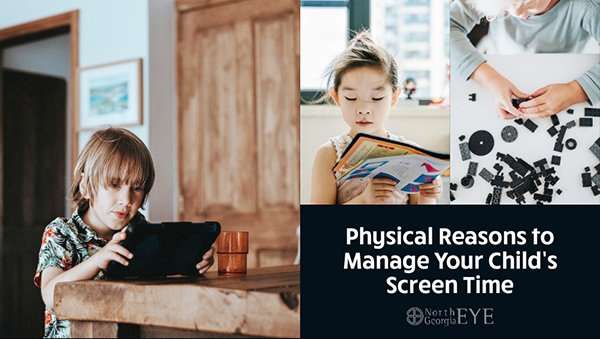Posted by: North Georgia Eye Associates in News,NGEC,Pediatric Ophthalmology

Screen Use For Kids

There are many reasons for parents to be thoughtful about how much screen time they allow their children. Amount of screen use per day has been associated with developmental outcomes, obesity, poor sleep quality, and eye development. Research from Canada has also found that preschoolers who had more than two hours of screen time per day had a nearly-8-fold increase in ADHD.
Expert organizations have created guidance for parents to help understand the facts uncovered in scientific research. The World Health Organization’s 2019 guidelines suggest no screen time at all for children before age 1, and very limited screen time for children for several years after that.
The American Academy of Pediatrics recommends no digital media use (except video-chatting) in children younger than 18 to 24 months and focusing on educational media when children do start using screens.
Effects of Screen Use on Children’s Eyes
The American Academy of Ophthalmology does not have specific recommendations for the amount of screen time for children. But parents should be aware of the possible effects of screen use on children’s eyes, as well as the broader health concerns raised by other groups like the WHO.
Myopia (Nearsightedness) and Close Work and Reading
The number of people developing nearsightedness in the United States has nearly doubled since 1971. In Asia, up to 90 percent of teenagers and adults are nearsighted, a dramatic increase over recent generations.
A 2019 study published in Ophthalmology—the journal of the American Academy of Ophthalmology—offers more evidence that at least part of the worldwide increase in nearsightedness has to do with near work activities. It’s not just screens affecting eye development, it’s also traditional books and the amount of time spent indoors overall. The study also found that spending time outdoors—especially in early childhood—can slow the progression of nearsightedness.
Digital Eye Strain
Digital eye strain isn’t a single eye condition, like glaucoma or pink eye. It’s a name for the kinds of symptoms that people experience when they spend too long looking at a screen. These symptoms can include dry eyes, itchy eyes, blurry vision, and headaches. These symptoms are temporary and no permanent damage is being done to the eyes.
The easiest way to avoid digital eye strain (or eye strain from any extended near-focus task like reading or sewing) is to make sure to blink often and to look up from your screen or close-up work every 20 minutes and focus at least 20 feet away for 20 seconds. This strategy of frequent re-focusing is called the 20-20-20 rule; it lets the eyes relax and reset.
Sleep Disruption from Screen Use
While some of the dangers of blue light may have been overhyped in recent years, screen use too close to bedtime can harm sleep quality. And sleep is important enough to childhood development that the World Health Organization made sleep one of the focuses of their latest recommendations.
Eye Comfort and Safety Tips for Children and Screens
The best way to deal with the possible effects of screens on children’s eyes and vision is to help them set good habits for use. These same tips are good practices for adults and anyone suffering from chronic dry eyes or eye strain.
- Follow the 20-20-20 rule: every 20 minutes, look at least 20 feet away for 20 seconds.
- Set a timer to remind the child how often to look into the distance.
- Alternate reading an e-book with a real book and encourage kids to look up and out the window every other chapter.
- After completing a level in a video game, look out the window for 20 seconds.
- Pre-mark books with a paperclip every few chapters to remind your child to look up. On an e-book, use the “bookmark” function for the same effect.
- Avoid using screens outside or in brightly lit areas, where the glare on the screen can create strain.
- Adjust the brightness and contrast of the screen so that it feels comfortable.
- Use good posture when using a screen. Poor posture can contribute to muscle tightness and headaches associated with eye strain.
- Encourage your child to hold digital media farther away: 18 to 24 inches is ideal.
- Remind them to blink when watching a screen.
————
The American Academy of Ophthalmology urges parents to manage their child’s screen time and help them develop good habits for use. This article was condensed from their EyeSmart article collection and was written by Dan Gudgel, reviewed by Rahul Khurana, MD, and edited by David Turbert. Read the full article, including a helpful video and resource links, at AAO.org.